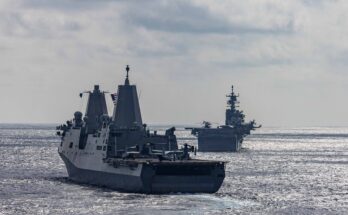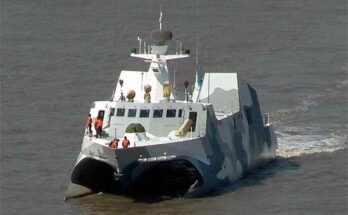by Stuart Slade, Warships Analyst, Forecast International.

The HMS Daring is an excellent ship, but the timing of its delivery was not ideal (Credit: Royal Navy)
A successful warship design needs to get four things right. Three of them are obvious. The ship must have the firepower needed to fulfill her role. She needs the speed to arrive at the scene of operation in timely manner, and she needs the range to get there. A successful warship design means ensuring that these three dimensions of a ship’s characteristics meet requirements and that those requirements are realistic.
This is no simple matter. Firepower is much more than embarked weaponry; it also includes sensors to detect targets and command systems to allocate weapons to the appropriate threats, as well as the provision of enough power to run these systems. Speed implies a more comprehensive design solution than just the ability to go fast. It means that the ship must be able to maintain that speed in foul weather and to do so without excessive fuel consumption. It also means that the ship must be reliable so that maintaining high speed for long periods does not overstrain the ship’s machinery. Range requires economical fuel consumption, reliable onboard systems, adequate supplies of ship’s stores, and the ability to operate at extended distances from home base. If achieving these three dimensions of ship performance were easy, every naval designer would do so. Of course, that is not the case.
Yet, the fourth dimension of a successful warship design is the most critical element. As every science fiction reader knows, the fourth dimension is time. If a new warship project fails to be properly timed, then it will be a failure even if the first three dimensions are perfect.
This was the tragedy of British Type 45 destroyers. When they finally arrived in the Royal Navy, they were everything that could be asked of the designers. However, the timing was wrong. Multiple false starts and a rigid determination to participate in multinational projects meant the class was so long in development that by the time the ships were being built, changes in government priorities saw the reassignment of the resources needed to complete the class in full. Only six ships of the 12 planned were completed, and these entered service more than 10 years later than originally planned.
In a larger sense, problems with the fourth dimension – that is, the need to time a program properly – are becoming increasingly common across the world. Technical complexity and risk combined with the sheer cost of modern defense programs are slowing down the execution of projects. At the same time, operational and strategic requirements are changing at an ever-increasing rate, driven by communications technology and data dissemination developments. It is becoming more and more difficult to produce warship designs in a timely manner and see them in service while the rationale for their development is still valid.
The solution to this dilemma is not easy to see. The current trend toward building ships that have a relatively simple, basic fit that can be supplemented by “mission packages” is one approach that has promise. This allows the operational capability of existing ships to be changed relatively quickly. Whether this approach is appropriate for ships that have to face the extreme upper end of the threat spectrum has yet to be determined. Nevertheless, without some radical development of the design process, dealing with the fourth dimension of warship programs will be arduous. Already, the world’s navies are asking warship specifiers and designers to look 10 or 15 years into the future and address the technical and operational requirements that will apply at that time rather than those apparent today.
For 50 years, Forecast International intelligence reports have been the aerospace and defense industry standard for accurate research, analysis, and projections. Our experienced analysts compile, evaluate, and present accurate data for decision makers. FI's market research reports offer concise analysis of individual programs and identify market opportunities. Each report includes a program overview, detailed statistics, recent developments and a competitive analysis, culminating in production forecasts spanning 10 or 15 years. Let our market intelligence reports be a key part of reducing uncertainties and mastering your specific market and its growth potential. Find out more at www.forecastinternational.com



